Saturation Spectroscopy on Rb
import pandas as pd
import scipy.optimize as opt
from routines import plot_data, four_gauss, plot_interval,gauss
from uncertainties import ufloat
from uncertainties import unumpy
import scipy.fftpack
import scipy.signal as signal
from statsmodels.nonparametric.smoothers_lowess import lowess
import matplotlib.patches as patches
from pandas.tools.plotting import table
import warnings
warnings.filterwarnings('ignore')
%pylab inline
# plt.rc('text', usetex=True)
# plt.rc('font', family='serif')
Populating the interactive namespace from numpy and matplotlib
# Dictionary that will be used to hold all data that will be processed in the bokeh script
bokeh_data = {}
Doppler Broadened Spectrum
Preprocessing
Import Raw Data
# import data
folder = "02-13/broadened/falling"
falling = True
path_doppler = "clean/" + folder + "/doppler.csv"
path_fp = "clean/" + folder + "/fp.csv"
doppler = pd.DataFrame.from_csv(path_doppler,index_col=None)
fp = pd.DataFrame.from_csv(path_fp,index_col= None)
#offsets
fp.t = fp.t
fp.V = fp.V/5
# show data
figsize(12,7)
plot_data(doppler,fp);
bokeh_doppler = pd.DataFrame(doppler)
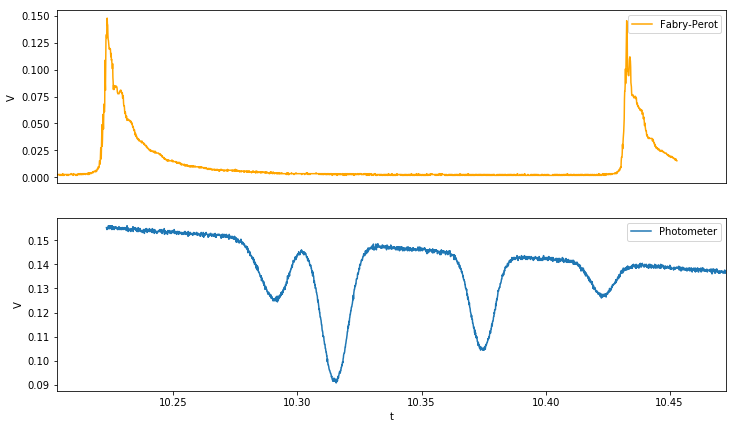
Remove Background
Remove the background signal that is a result of the rectangular modulation in laser current.
def remove_background(data, fit_data, func, initial_guess = None):
par,cov = opt.curve_fit(func,fit_data.t,fit_data.V,initial_guess)
data_clean = data.copy()
data_clean.V = data.V-func(data.t,*par)
return data_clean , par
def lin(x,a,b): # linear function for fit
return a*x+b
# For background, only fit parts without peaks
fit_subset = doppler[:200].append(doppler[-20:])
photo_nb , par = remove_background(doppler,fit_subset,lin)
photo_nb.V = photo_nb.V
figsize(9,5)
plot_data(photo_nb,fp);
#savefig('broadened.pdf')
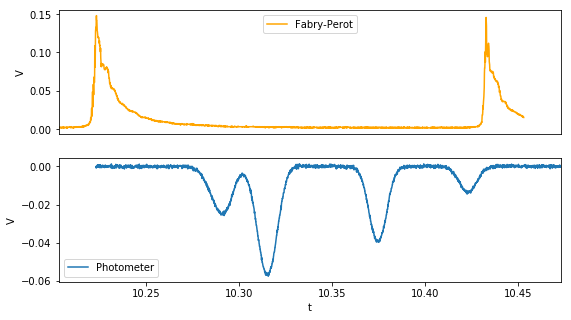
Analyze Fabry-Perot
The Fabry-Perot spectrum is used to calibrate the time-axis on the oscilloscope. The FP spectrometers peaks are always separated by 10 Ghz, this is called the free spectral range or FSR.
#left maximum
fp_lpeak = np.array(fp[0:math.floor(len(fp.t)/2)].sort_values('V').t)[-1]
#right maximum
fp_rpeak = np.array(fp[math.floor(len(fp.t)/2):].sort_values('V').t)[-1]
fsr = fp_rpeak - fp_lpeak
figsize(12,7)
plot_data(photo_nb,fp)
def plot_fplines(subplots =2):
for i in range(min(2,subplots)):
subplot(subplots,1,i+1)
axvline(fp_lpeak, ls = '--',color = 'grey')
axvline(fp_rpeak, ls = '--', color = 'grey')
plot_fplines()
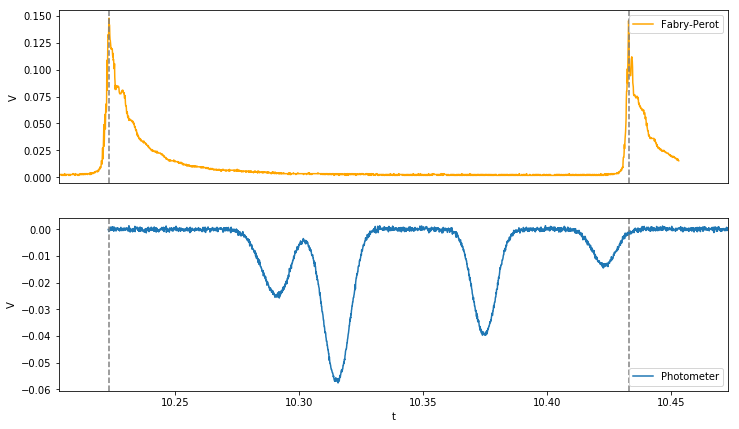
Analyze Photometer spectrum
# Fit the data
# Load file with save values for mu if it exists. If not use mu_guess and save later if success.
# mu corresponds to the peak positions in the doppler broadened spectrum. To achieve convergence of the
# least square fitting algorithm, a good initial guess should be provided.
try:
mu_file = open("./clean/" + folder + "/mu_guess",'r')
mu_guess = []
for line in mu_file:
mu_guess += [float(line.strip())]
except FileNotFoundError as e:
mu_guess=[10.03,10.06,10.12,10.14]
guess = [-.05,-.05,-.05,-.05,*mu_guess,.005,.005,.005,.005]
par, cov = opt.curve_fit(four_gauss, photo_nb.t, photo_nb.V, guess)
### Peaks and uncertainties
#peaks[{x:0/y:1}][index]
peaks = np.array([par[4:8],par[0:4]])
#their errors (1 sigma)
peaks_err = np.array([[np.sqrt(cov[i,i]) for i in range(4,8)],[np.sqrt(cov[i,i]) for i in range(0,4)]])
# Data Frame with peak positions and heights
index = ['87_F2','85_F3','85_F2','87_F1']
if not falling:
index = index[::-1]
spectrum = pd.DataFrame({'x' : pd.Series(par[4:8],index),
'y': pd.Series(par[0:4],index),
'sig_x': pd.Series(peaks_err[0],index),
'sig_y': pd.Series(peaks_err[1],index),
'width': pd.Series(par[8:12],index),
'sig_width': pd.Series([np.sqrt(cov[i,i]) for i in range(8,12)],index)})
spectrum
| x | y | sig_x | sig_y | width | sig_width | |
|---|---|---|---|---|---|---|
| 87_F2 | 10.290474 | -0.024994 | 0.000018 | 0.000068 | 0.005608 | 0.000018 |
| 85_F3 | 10.315141 | -0.057517 | 0.000007 | 0.000071 | 0.005175 | 0.000008 |
| 85_F2 | 10.374536 | -0.039835 | 0.000010 | 0.000074 | 0.004653 | 0.000010 |
| 87_F1 | 10.422916 | -0.013536 | 0.000030 | 0.000074 | 0.004675 | 0.000030 |
Plotting
figsize(12,8)
if np.mean(photo_nb.V) < 0:
photo_nb.V = -photo_nb.V
xl = plot_data(photo_nb,fp,subplots=3)
ylabel('Fabry-Perot [V]')
subplot(3,1,2)
plot(photo_nb.t,-four_gauss(photo_nb.t,*par),label = 'Gaussian Fit',color = 'red',linewidth = 1)
xticks([])
xlabel('')
ylabel('Absorption [mV]')
yticks(np.arange(0,0.051,0.025), np.arange(0,51,25))
plot_fplines(3)
subplot(3,1,3)
xlabel('Frequency [Ghz]')
#xticks(np.arange(-5,5,1))
xlim(xl)
yticks([])
for i in range(2,4):
for pos in spectrum.x:
subplot(3,1,i)
axvline(pos,color= 'darkgrey',ls = '--')
subplot(3,1,3)
scale = 10e3/fsr #MHz
xticks(np.arange(-6000,6000,2000)/scale +10.35,np.arange(-6,6,2))
##uncertainties in intervals
interval_32 = ufloat(abs(spectrum.x['85_F2']-spectrum.x['85_F3']),np.sqrt(spectrum.sig_x['85_F2']**2+spectrum.sig_x['85_F3']**2))
interval_21 = ufloat(abs(spectrum.x['87_F1']-spectrum.x['87_F2']),np.sqrt(spectrum.sig_x['87_F1']**2+spectrum.sig_x['87_F2']**2))
plot_interval(spectrum.x['85_F3'],spectrum.x['85_F2'],0.35,
str(round(interval_32.n*scale/1000,2)) + " GHz" ,.0174)
plot_interval(spectrum.x['87_F2'],spectrum.x['87_F1'],0.65,
str(round(interval_21.n*scale/1000,2)) + " GHz",.0174)
subplot(3,1,1)
plot_interval(fp_lpeak,fp_rpeak,.1, " 10 Ghz",.013,hw = .02)
ax = subplot(3,1,1)
text(0.02, 0.95, 'a)', transform=ax.transAxes,
fontsize=16, fontweight='bold', va='top')
ax = subplot(3,1,2)
text(0.02, 0.95, 'b)', transform=ax.transAxes,
fontsize=16, fontweight='bold', va='top')
legend(loc=1)
ax = subplot(3,1,3)
text(0.02, 0.95, 'c)', transform=ax.transAxes,
fontsize=16, fontweight='bold', va='top');
# savefig("./clean/" + folder + "/spectrum.pdf",bbox_inches='tight')
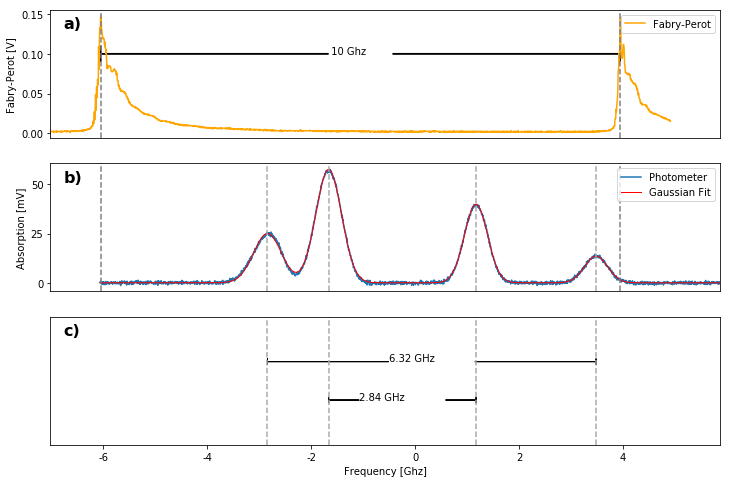
Save mu
with open("./clean/" + folder + "/mu_guess",'w') as mu_file:
for mu in mu_guess:
mu_file.write(str(mu)+'\n')
Saturated Spectrum
Preprocessing
Import Data
folder = "02-13/saturated/falling"
path_saturated = "clean/" + folder + "/saturated.csv"
path_doppler = "clean/" + folder + "/doppler.csv"
saturated = pd.DataFrame.from_csv(path_saturated,index_col=None)
doppler = pd.DataFrame.from_csv(path_doppler,index_col= None)
# show data
figsize(9,5)
plot(saturated.t,saturated.V);
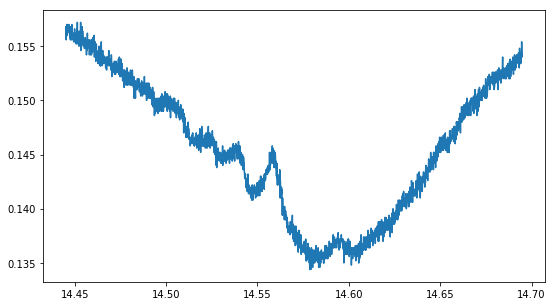
# Functions used for fitting the spectrum
def lorentzian(x,N,x0,gamma):
return N/((1+((x-x0)/gamma)**2))
def two_gauss_os(x,N1,N2,mu1,mu2,sig1,sig2,os):
return gauss(x,N1,mu1,sig1) + gauss(x,N2,mu2,sig2) + os
def gauss_os(x,N1,mu1,sig1,os):
return gauss(x,N1,mu1,sig1) + os
def lin(x,a,b):
return a*(x)+b
Compare doppler broadened and saturated
We “zoomed in” on one peak - 87Rb(F = 2 -> ?) - and recorded the unsaturated and saturated spectrum
figsize(10,10)
background = doppler.copy()
# These parameters have to be hand-adjusted for every Dataset for good agreement
#background.t += 0.016 # 02-13 rising
background.t -= 0.005 # 02-13 falling
#background.V += 0.0105 # 02-13 rising
background.V += 0.0111 # 02-13 falling
merged = pd.merge(background,saturated, how='inner',on=['t'])
plot(merged.t,merged.V_x, label = 'Unsaturated')
plot(merged.t,merged.V_y, label = 'Saturated')
legend();
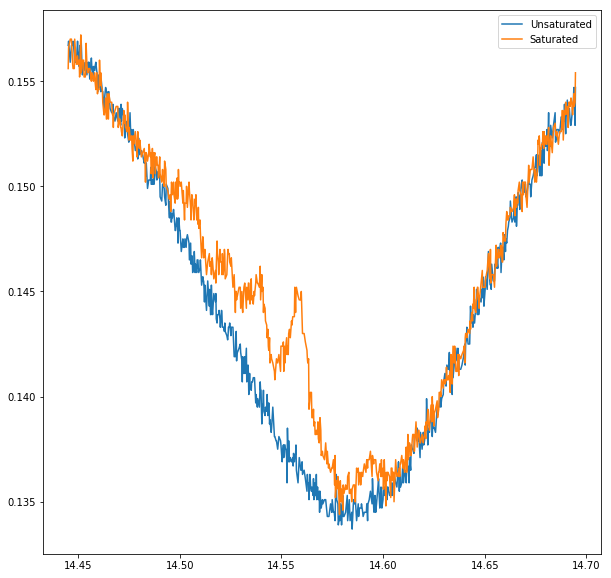
Subract linear background from absorption spectrum
Again, we have to subract the linear background produced by the current modulation from both signals
lin_fit_data = background[background.t < 14.38] # 02-13 falling
#lin_fit_data = background[background.t> 12.03] # 02-13 rising
par_back_lin, cov_back_lin = opt.curve_fit(lin,lin_fit_data.t,lin_fit_data.V)
subplot(2,1,1)
plot(background.t,background.V)
plot(background.t,lin(background.t,*par_back_lin))
background.V = background.V-lin(background.t,*par_back_lin)
subplot(2,1,2)
plot(background.t,background.V)
axhline(0,color ='green')
<matplotlib.lines.Line2D at 0x7f1f50f777f0>
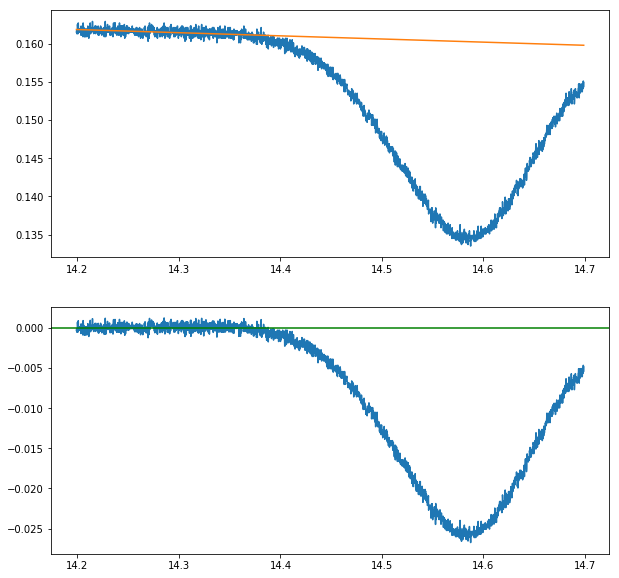
Because we cannot use the FP spectrometer to calibrate the time axis in this case, we fit the unsaturated peak and compare its width to the corresponding peak’s in our previous measurement. As both widhts should be the same in frequency, we can easily determine the scaling factor.
#Fit doppler broadened (unsaturated) peak (to determine scaling factor)
figsize(7,5)
#guess = [-0.04,-0.02,11.6,11.85,.1,.1,0.16] # 02-13 rising
guess = [-0.04,14.6,.1,0.16] # 02-13 falling
fit_func = gauss_os # 02-13 falling
#fit_func = two_gauss_os # 02-13 rising
#par_background, cov_background = opt.curve_fit(two_gauss_os,background.t,background.V,guess) # 02-13 rising
par_background, cov_background = opt.curve_fit(fit_func,background.t,background.V,guess) # 02-13 falling
plot(background.t,background.V)
plot(background.t,fit_func(background.t,*par_background),lw = 3)
scattersigma = np.sqrt(((background.V-fit_func(background.t,*par_background))**2).sum())/np.sqrt(len(background.V))
#sigma_background = ufloat(par_background[5],cov_background[5,5]) # 02-13 rising
sigma_background = ufloat(par_background[2],np.sqrt(cov_background[2,2])) # 02-13 falling
F2_width_doppler = ufloat(spectrum.width['87_F2'],spectrum.sig_width['87_F2'])
scale_sat = F2_width_doppler*scale/sigma_background
print(' The scaling factor between the doppler broadened measurement and the saturated ' +\
' measurement is {}'.format(scale_sat))
The scaling factor between the doppler broadened measurement and the saturated measurement is 3947+/-14
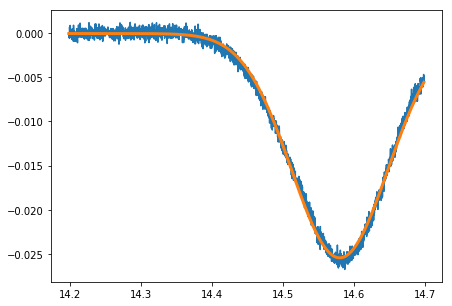
Signal processing
Because we are measuring with a very high resolution, the signal contains a lot of noise that we can filter out by employing a method call LOWESS (Locally Weighted Scatterplot Smoothing). The hyperparameters of this smoothening algorithm should be hand-tuned to achieve good results
figsize(12,8)
sat_nb = pd.DataFrame([merged.t,(merged.V_y-merged.V_x)])
sat_nb = sat_nb.transpose()
sat_nb.columns = ['t','V']
sat_nb.head()
ax = subplot(3,1,1)
ax.set_xticks([])
ax.set_yticks([])
plot(merged.t,merged.V_y)
plot(merged.t,merged.V_x)
ax = subplot(3,1,2)
ax.set_xticks([])
ax.set_yticks([])
plot(sat_nb.t,sat_nb.V)
### ============ LOWESS smoothening, hand-tune here !!! ==================
#filtered = lowess(sat_nb.V,sat_nb.t,frac = 0.018, it=0) # 02-13 rising
filtered = lowess(sat_nb.V,sat_nb.t,frac = 0.028, it=0) # 02-13 falling
sat_filtered = pd.DataFrame([filtered[:,0],filtered[:,1]])
sat_filtered = sat_filtered.transpose()
sat_filtered.columns = ['t','V']
ax = subplot(3,1,3)
ax.set_xticks([])
plot(sat_filtered.t,sat_filtered.V/scattersigma)
#axhline(1,ls='--',color='grey',label='2$\sigma$')
axhline(2,ls='--',color='grey',label='2$\sigma$')
ax.set_ylabel("$\sigma$")
ax.set_yticks([0,2,10])
#legend()
ax = subplot(3,1,1)
text(0.02, 0.85, 'a)', transform=ax.transAxes,
fontsize=16, fontweight='bold', va='top')
ax = subplot(3,1,2)
text(0.02, 0.95, 'b)', transform=ax.transAxes,
fontsize=16, fontweight='bold', va='top')
ax = subplot(3,1,3)
text(0.02, 0.95, 'c)', transform=ax.transAxes,
fontsize=16, fontweight='bold', va='top');
# savefig("./clean/"+ folder + "/data_manip.pdf",bbox_inch='tight')
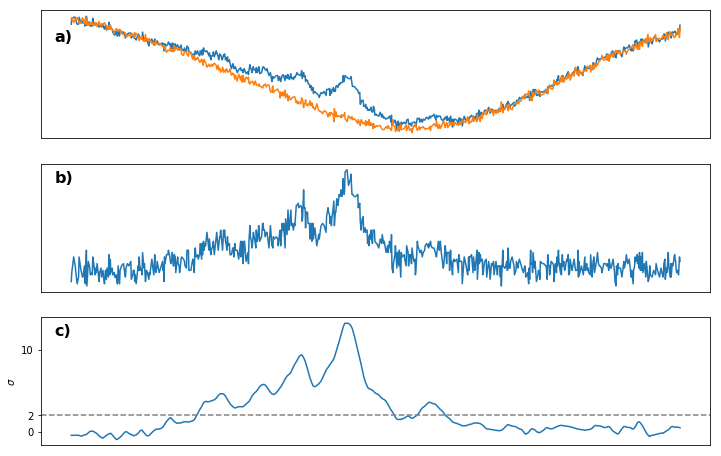
a) Saturated and Unsaturated spectrum
b) Saturated - Unsaturated spectrum
c) Spectrum from b) smoothened with LOWESS and normalized to the standard deviation $\sigma$ of the noise. Dashed grey line gives the cutoff $2\sigma$ that we require to identify a peak as such
Analysis
figsize(12,8)
# ============ Some fitting parameters that need to be hand tuned ============
# width: approximate width of the peaks
# left-pos: approximate peak position - width / 2
# parameters don't have to be exact, just in the ballpark of the actual peaks
width = [0.004,0.004,0.006,0.006,0.006,0.006]
#left_pos = [11.815,11.848,11.866,11.878,11.898,11.912] # 02-13 rising
left_pos = [14.484,14.504,14.521,14.536,14.5555,14.59] # 02-13 falling
# truncate data so only important peaks are shown
sat_filtered_trunc = sat_filtered[(sat_filtered.t > (left_pos[0] - 2*width[0])) &
(sat_filtered.t < (left_pos[-1] + 4*width[0]))]
fig,ax = subplots()
ax.plot(sat_filtered_trunc.t,sat_filtered_trunc.V,label = 'Filtered Signal')
axhline(scattersigma*2,ls='-',color='grey',alpha=.3)
par_peaks = []
par_peaks_xerr = []
labels = ['F=3','CO','CO','F=2','CO',"F=1?"]
if falling:
labels = labels[::-1]
i = 0
# Fitting the data for each area and plotting the fitted functions,
# parameters are saved in par_peaks
peak_sig = []
for x,w in zip(left_pos,width):
fit_data = sat_filtered_trunc[(sat_filtered_trunc.t > x) & (sat_filtered_trunc.t < (x+w))]
#ax.plot(fit_data.t,fit_data.V)
x0 = x+w/2
N = max(fit_data.V)
gamma = w
par, cov = opt.curve_fit(lorentzian,fit_data.t,fit_data.V,[N,x0,gamma])
plt_label = "x0=" + str(par[1])
ax.plot(fit_data.t,lorentzian(fit_data.t,*par),label=plt_label)
ax.annotate(labels[i],xy = (par[1]-0.005,par[0]+0.0001),textcoords='data')
axvline(par[1],ls = "--", alpha = .3)
par_peaks.append(par)
peak_sig.append(np.sqrt(cov[1,1]))
i+=1
#Data frame with parameters
ylim([-0.001,0.0083])
ylabel("$\sigma$")
xlabel("Frequency [MHz]")
spectrum_sat = pd.DataFrame(par_peaks)
spectrum_sat.columns = ['y','x','width']
spectrum_sat.index = labels
#axvline((spectrum_sat.x['F=2']-157.1/scale_sat).n,color ='green', ls='--', alpha = .3)
u_x = [ufloat(x,peak_sig[cnt]) for (x,cnt) in zip(spectrum_sat.x,range(len(spectrum_sat.x)))]
spectrum_sat['x'] = u_x
spectrum_sat.x = (spectrum_sat.x)*scale_sat
yticks(np.arange(0,16,2)*scattersigma,np.arange(0,16,2))
xticks([x.n/scale_sat.n for x in spectrum_sat.x],[round(x.n-spectrum_sat.x["F=2"].n,2) for x in spectrum_sat.x])
# savefig("./clean/" + folder + "/hyperfine_spectrum.pdf",bbox_inches='tight')
# legend()
spectrum_sat
| y | x | width | |
|---|---|---|---|
| F=1? | 0.000955 | (5.717+/-0.021)e+04 | 0.002708 |
| CO | 0.002669 | (5.726+/-0.021)e+04 | 0.006048 |
| F=2 | 0.003303 | (5.732+/-0.021)e+04 | 0.006505 |
| CO | 0.005327 | (5.738+/-0.021)e+04 | 0.006669 |
| CO | 0.007679 | (5.746+/-0.021)e+04 | 0.007452 |
| F=3 | 0.002045 | (5.759+/-0.021)e+04 | 0.006905 |
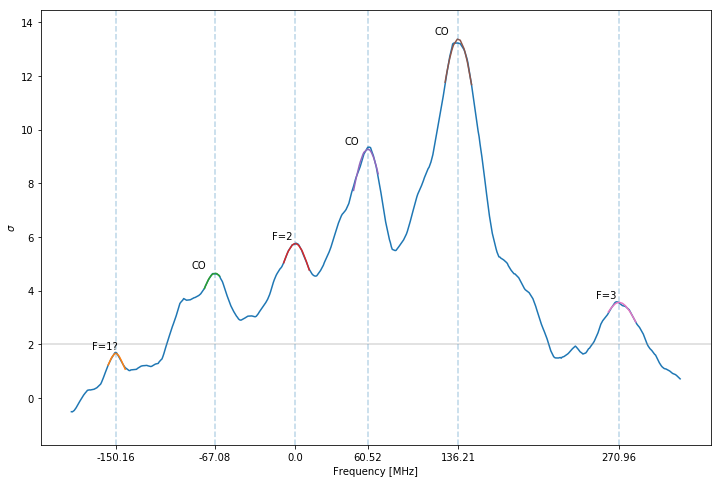
The peaks are fitted with lorentzians as indicated by the colored regions. The peak positions are given by the dashed vertical lines and labeled accordingly, where CO stands for cross-over peak (see paper for more information). Again the y-axis (Intensity) is normalized to the standard deviation of the noise.
Comparison to theory
Doppler Broadened
# Some natural constants
kb = 1.38065e-23
c = 299792558
T = 295.15
M_85 = 1.409993e-25
def two_gauss(x,N1,N2,mu1,mu2,sig1,sig2):
return gauss(x,N1,mu1,sig1)+ gauss(x,N2,mu2,sig2)
Import data from csv file
Theoretical values from
P. Siddons, C. S. Adams, C. Ge, and I. G. Hughes, Jour- nal of Physics B: Atomic, Molecular and Optical Physics11 41, 155004 (2008)
sff = pd.DataFrame.from_csv('parameters/sff.csv')
freq = pd.DataFrame.from_csv('parameters/freq.csv')
d_line_87 = 384.2304844e6
d_line_85 = 384.2304064e6
frequencies_85 = np.zeros([2,4])
for i in range(2):
for j in range(i,i+3):
frequencies_85[i,j] = d_line_85 + freq['Rb85-S'][2+i] + freq['Rb85-P'][1+j]
df_freq_85 = pd.DataFrame(frequencies_85,columns=['1','2','3','4'],index = ['2','3'])
frequencies_87 = np.zeros(8).reshape(2,4)
for i in range(2):
for j in range(i,i+3):
frequencies_87[i,j] = d_line_87 + freq['Rb87-S'][1+i] + freq['Rb87-P'][j]
df_freq_87 = pd.DataFrame(frequencies_87,columns=['0','1','2','3'],index = ['1','2'])
Rb85 expected spectrum
sigma_85 = np.array(np.sqrt(kb*T/(M_85*(c**2)))*df_freq_85).flatten()
mu_85 = np.array(df_freq_85 - df_freq_85['1'][0]).flatten()
N_85 = np.array(sff[2:4])[:,1:5].flatten()
np.array(df_freq_85).flatten()
# x= np.arange(-6000,3000,10)
x = photo_nb.t*scale - spectrum.x['85_F2']*scale
y_85= np.zeros(len(x))
y_gauss_85 = []
for i in range(8):
if(sigma_85[i] != 0):
y_85 += gauss(x,N_85[i],mu_85[i],sigma_85[i])
plot(x,gauss(x,N_85[i],mu_85[i],sigma_85[i]),color = 'grey',ls = '--')
y_gauss_85.append(gauss(x,N_85[i],mu_85[i],sigma_85[i]))
else:
y_gauss_85.append(np.zeros(len(x)))
par_85, cov = opt.curve_fit(two_gauss,x,y_85,[1,1,-3000,0,217,217])
plot(x,y_85)
plot(x,two_gauss(x,*par_85))
[<matplotlib.lines.Line2D at 0x7f1f50f5b6a0>]
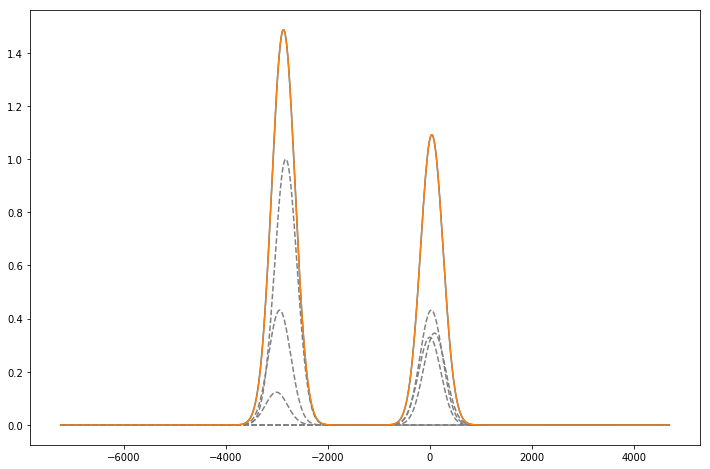
Rb87 expected spectrum
M_87 = 1.44316077e-25
sigma_87 = np.array(np.sqrt(kb*T/(M_87*(c**2)))*df_freq_87).flatten()
mu_87 = np.array(df_freq_87 - df_freq_85['1'][0]).flatten() - 80
N_87 = np.array(sff[0:2])[:,0:4].flatten()
figsize(6,4)
# x = np.arange(-6000,3000,10)
x = photo_nb.t*scale - spectrum.x['85_F2']*scale
y_87= np.zeros(len(x))
y_gauss_87 = []
for i in range(8):
if(sigma_87[i] != 0):
y_87 += gauss(x,N_87[i],mu_87[i],sigma_87[i])
plot(x,gauss(x,N_87[i],mu_87[i],sigma_87[i]),color = 'grey',ls = '--')
y_gauss_87.append(gauss(x,N_87[i],mu_87[i],sigma_87[i]))
else:
y_gauss_87.append(np.zeros(len(x)))
plot(x,y_87)
xticks(np.arange(-6000,3000,2000),np.arange(-6,3,2))
par_87, cov = opt.curve_fit(two_gauss,x,y_87,[.7,1,-4000,2000,217,217])
plot(x,two_gauss(x,*par_87))
scale_85 = abs(spectrum.y['85_F3'])/par_85[0]
scale_87 = abs(spectrum.y['87_F1'])/par_87[1]
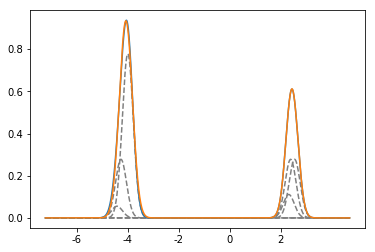
Spectrum for both Rb isotopes - Theory compared to experiment
Quantitative comparison
#Gaps
gap_87 = abs((ufloat(spectrum.x['87_F2'],spectrum.sig_x['87_F2']) - ufloat(spectrum.x['87_F1'],
spectrum.sig_x['87_F1']))*scale)
gap_85 = abs((ufloat(spectrum.x['85_F3'],spectrum.sig_x['85_F3']) - ufloat(spectrum.x['85_F2'],
spectrum.sig_x['85_F2']))*scale)
expected_gap_87 = par_87[3] - par_87[2]
expected_gap_85 = par_85[3] - par_85[2]
#Ratio of amplitudes
amp_87 = abs((ufloat(spectrum.y['87_F2'],spectrum.sig_y['87_F2'])/ufloat(spectrum.y['87_F1'],
spectrum.sig_x['87_F1'])))
amp_85 = abs((ufloat(spectrum.y['85_F3'],spectrum.sig_y['85_F3'])/ufloat(spectrum.y['85_F2'],
spectrum.sig_x['85_F2'])))
expected_amp_87 = par_87[0]/par_87[1]
expected_amp_85 = par_85[0]/par_85[1]
results_doppler = pd.DataFrame([[expected_gap_87,gap_87],[expected_gap_85,gap_85],[expected_amp_87,amp_87],
[expected_amp_85,amp_85]])
results_doppler.columns = ['Theoretical', 'Measured']
results_doppler.index = ['Gap Rb87', 'Gap Rb85', 'Amp. ratio Rb87', 'Amp. ratio Rb85']
Plotting
figsize(12,8)
ax = subplot(2,1,1)
text(0.02, 0.95, 'a)', transform=ax.transAxes,
fontsize=16, fontweight='bold', va='top')
i = 0
theory_ds = pd.DataFrame()
theory_ds['t'] = x - par_87[3]
for j, y_g_85 in enumerate(y_gauss_85):
if i is 0:
plot(x-par_87[2],y_g_85 * scale_85,color = 'grey',ls = '--',lw = .8,label = 'Hyperfine trans.')
i = 1
else:
plot(x-par_87[2],y_g_85 * scale_85,color = 'grey',ls = '--',lw = .8,label = '_nolegend_')
theory_ds['hyperfine_{}'.format(j)] = y_g_85 * scale_85
for j, y_g_87 in enumerate(y_gauss_87):
plot(x-par_87[2],y_g_87 * scale_87,color = 'grey',ls = '--',lw = .8)
theory_ds['hyperfine_{}'.format(j+len(y_gauss_85))] = y_g_87 * scale_87
plot((photo_nb.t-spectrum.x['87_F2'])*scale,photo_nb.V, color = 'grey',alpha = 0, label = '_nolegend_')
plot(x-par_87[2],y_85 * scale_85 + y_87 * scale_87,color = 'red', label = 'Sum')
xticks(np.arange(-2000,10000,2000),np.arange(-2,10,2))
xticks([])
yticks([])
legend()
ax = subplot(2,1,2)
text(0.02, 0.95, 'b)', transform=ax.transAxes,
fontsize=16, fontweight='bold', va='top')
plot((photo_nb.t-spectrum.x['87_F2'])*scale,photo_nb.V, color = 'grey',label = 'Data')
plot(x-par_87[2],y_85 * scale_85 + y_87 * scale_87,color = 'red', label = 'Model')
ylabel('Absorption [V]')
xlabel('Frequency [GHz]')
xticks(np.arange(-2000,10000,2000),np.arange(-2,10,2))
legend()
# savefig("./clean/" + folder + "/theory_doppler.pdf",bbox_inches='tight')
results_doppler
| Theoretical | Measured | |
|---|---|---|
| Gap Rb87 | 6511.541455 | 6324.8+/-1.6 |
| Gap Rb85 | 2909.527534 | 2836.4+/-0.6 |
| Amp. ratio Rb87 | 1.527590 | 1.846+/-0.006 |
| Amp. ratio Rb85 | 1.361749 | 1.4439+/-0.0018 |
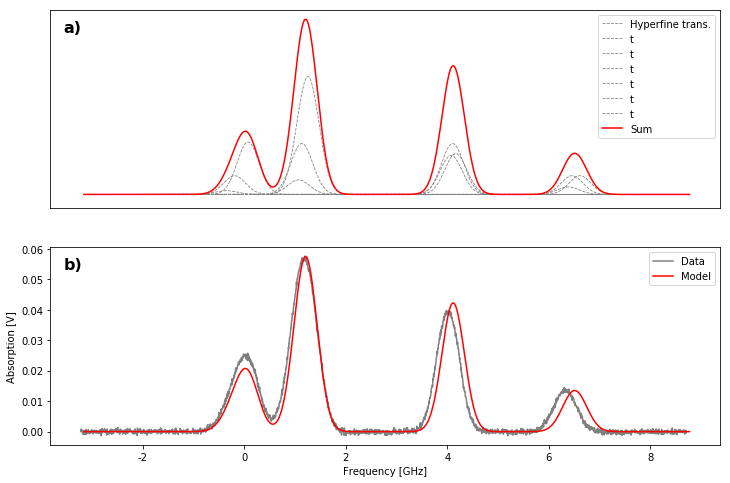
a) Dashed grey lines: Hyperfine peaks that make up the doppler broadened peaks (red solid line) - Theoretical values
b) Comparison of the theoretical values (model) to the measured ones (data).
photo_nb.t = (photo_nb.t-spectrum.x['87_F1'])*scale/1000
fp.t = (fp.t-spectrum.x['87_F1'])*scale/1000
theory_ds.t /= 1000
photo_nb['photo_nb'] = photo_nb.V
photo_nb = photo_nb.drop('V', axis = 1)
master_df = pd.merge_asof(photo_nb, theory_ds, on = ['t'])
bokeh_doppler.t = (bokeh_doppler.t -spectrum.x['87_F1'])*scale/1000
bokeh_doppler['photo_raw'] = bokeh_doppler.V
bokeh_doppler = bokeh_doppler.drop('V', axis = 1)
master_df = pd.merge_asof(master_df, bokeh_doppler, on = ['t'] )
bokeh_data['Broadened'] = master_df
bokeh_data['FP'] = fp
Saturated
plot((sat_filtered_trunc.t- spectrum_sat.x['F=2'].n/scale_sat.n)*scale_sat.n,sat_filtered_trunc.V,
label = 'Data',color = 'grey')
labels = ['F=1 (theory)','F=2 (theory)', 'F=3 (theory)','']
colors = ['red','green','blue']
i = 0
for line_x in (freq['Rb87-P']-freq['Rb87-P'][2])[1:4]:
axvline(line_x,lw = .9,color = colors[i], label = labels[i])
i+= 1
yticks([])#Quantitative comparison
ylabel("Absorption")
xlabel('Frequency [MHz]')
legend()
# savefig("./clean/" + folder + "/theory_sat.pdf",bbox_inches='tight')
None
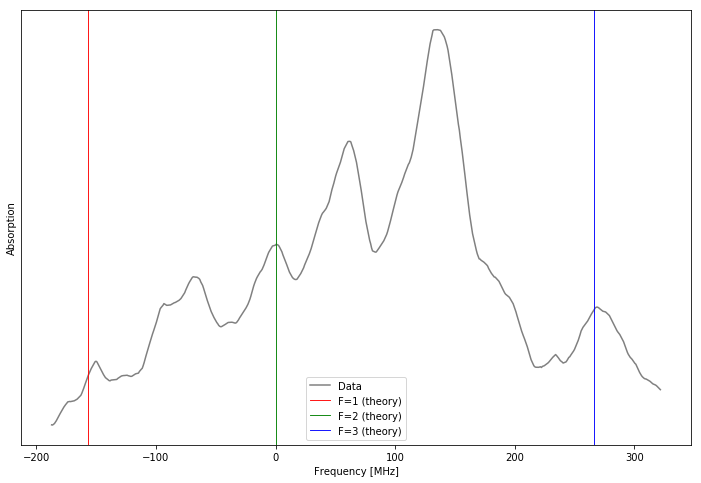
Figure: Measured absorption spectrum for saturated spectroscopy compared to model predictions. The colored vertical lines give the peak positions predicted by our theoretical model. The y-axis is the absorption strength in arbitrary units.
merged.columns = ['t','sat_background','sat_raw']
sat_nb.columns = ['t','sat_nb']
sat_filtered.columns = ['t', 'sat_filtered']
bokeh_data['Saturated'] = pd.merge_asof(merged,sat_nb, on =['t'])
bokeh_data['Saturated'] = pd.merge_asof(bokeh_data['Saturated'],sat_filtered, on = ['t'])
bokeh_data['Saturated'].t -= par_background[1]
bokeh_data['Saturated'].t *= scale_sat.n